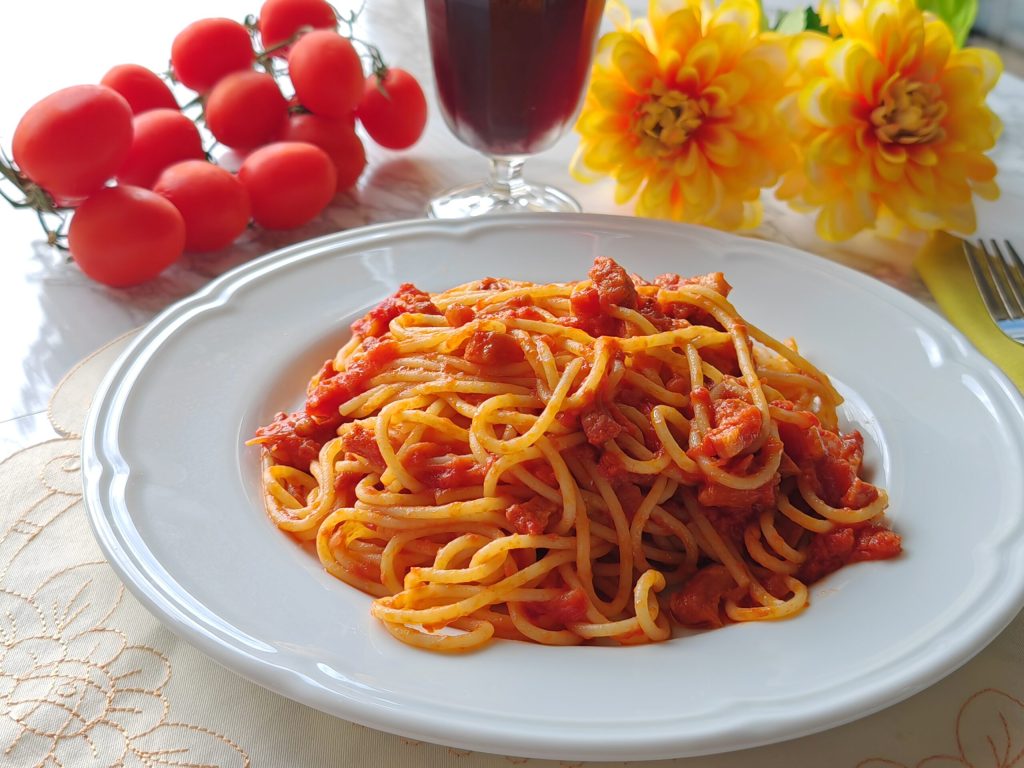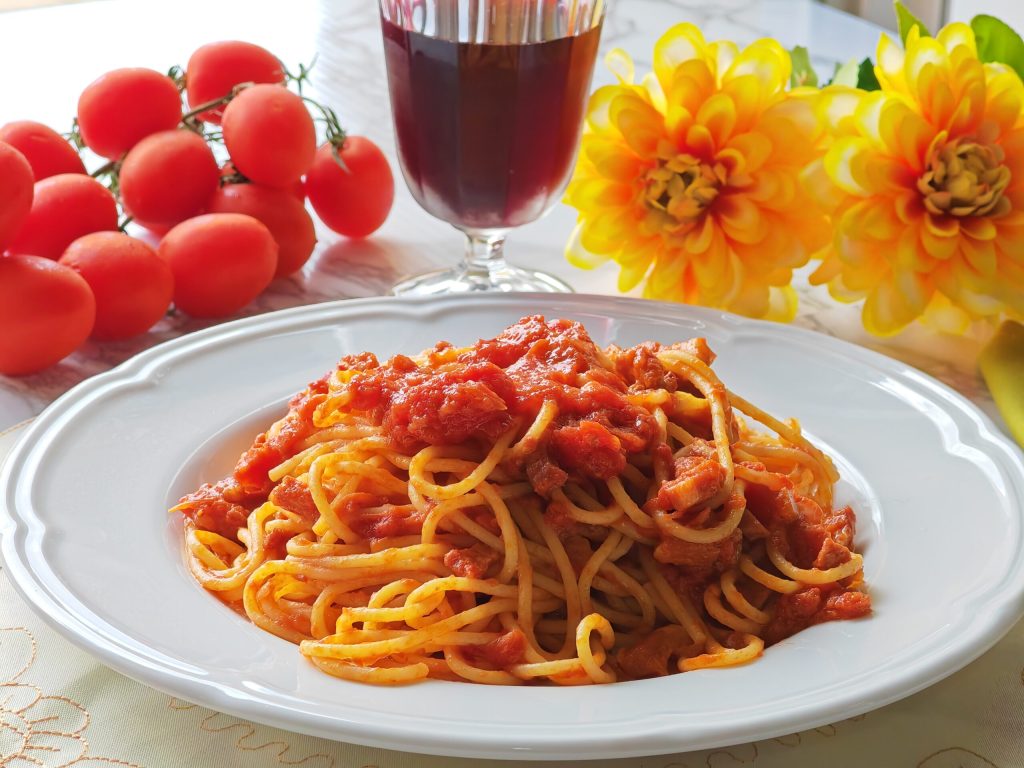Pasta all’amatriciana, an easy recipe of one of the most famous dishes in Italian cuisine and around the world, perfect for a hearty lunch with family or friends.
Pasta all’amatriciana, just saying it makes your mouth water. Yes! Just pronouncing the word “amatriciana” evokes a certain craving.
One of the tastiest Italian dishes, pasta all’amatriciana is the perfect pasta for those who want to bring a delicious and rustic first course to the table, yet so simple to make.
Many have different ideas about what the original amatriciana recipe is.
According to the original recipe from Amatrice, the ingredients are simple and genuine. It’s an easy and quick preparation, but to enhance its goodness, always use high-quality products and meticulously follow the procedure.
Some use spaghetti and some use bucatini, some use pancetta and others use guanciale.
What is certain is that it is a simple dish of rural origins. It sure was an evolution of gricia, which is practically the same but doesn’t include tomato.
But is it “amatriciana” or “matriciana”? Indeed, you may have often heard it as “matriciana,” but the correct name is undoubtedly the first one.
What should not be missing from this dish is pecorino and pepper, which give a nice boost to the final savory taste.
What a fantastic first course this is!
If you want to know how to make the perfect amatriciana recipe, follow my tips and taste the flavor!
Come on, let’s head to the kitchen.

- Difficulty: Very easy
- Cost: Very cheap
- Preparation time: 15 Minutes
- Portions: 4
- Cooking methods: Stove
- Cuisine: Italian
- Seasonality: All seasons
- Energy 466.16 (Kcal)
- Carbohydrates 25.29 (g) of which sugars 0.46 (g)
- Proteins 11.01 (g)
- Fat 34.23 (g) of which saturated 13.38 (g)of which unsaturated 16.78 (g)
- Fibers 1.64 (g)
- Sodium 1,625.28 (mg)
Indicative values for a portion of 190 g processed in an automated way starting from the nutritional information available on the CREA* and FoodData Central** databases. It is not food and / or nutritional advice.
* CREATES Food and Nutrition Research Center: https://www.crea.gov.it/alimenti-e-nutrizione https://www.alimentinutrizione.it ** U.S. Department of Agriculture, Agricultural Research Service. FoodData Central, 2019. https://fdc.nal.usda.gov
Ingredients for Pasta all’amatriciana
- 11 oz spaghetti (or bucatini)
- 5.5 oz guanciale
- 2.5 oz pecorino romano (to be grated)
- 1/4 cup dry white wine
- chili pepper (optional)
- salt
- pepper
Tools
- Frying pan
- Colander
- Pot
- Lids
Steps for Pasta all’amatriciana
To make pasta all’amatriciana, first slice the guanciale into strips not too thin, then place it in a pan.
Tip: Cut guanciale into strips about an inch long.
(A cast-iron pan is ideal, but if you don’t have one, use a non-stick pan.)
Turn on the heat and slowly melt the fat, being careful not to burn it.
Until it becomes crispy, yet translucent. This is important because the guanciale must melt slowly.
Once the guanciale is well browned, add the chili pepper, and then deglaze with white wine.
Let it evaporate, drain the guanciale, and keep it warm.
Add the tomato to the same pan (containing the cooking base of the guanciale) (if using peeled tomatoes, mash them with a fork), season with salt but do not overdo it.
Cook for about 10 minutes to thicken the sauce a bit. Remove the chili pepper.
At the end of cooking, add the guanciale that you set aside.

In the meantime, cook the pasta in plenty of salted water.
Drain the pasta al dente, transferring it directly into the pan with the sauce, and let it absorb the flavors (if necessary, to complete the cooking of the pasta, you can add some pasta cooking water).
Quickly toss the pasta to blend it well with the sauce
Turn off the heat, add a sprinkle of grated Pecorino Romano DOP.
Ready to be served!

Ready to be served!

Bon appétit.

Tips
Tips
For a capital “A” Amatriciana, Pecorino Romano DOP is fine, better yet the one from Amatrice.
To brown the guanciale, as you can see, no other fats are used; at most, you can add a little olive oil, but it is not necessary. The fat from the guanciale, as it melts, will create the right base to flavor the sauce.
It is advisable to consume spaghetti all’amatriciana immediately. They can be stored for up to 1 day in the fridge.
If you liked this recipe, click on many stars, thank you very much.
I’ll be waiting for you in my group: https://www.facebook.com/groups/488624465780860
or on my page: https://www.facebook.com/gustoamoreefantasie
FAQ (Questions and Answers)
Can I use pancetta?
Because guanciale is more delicate, with its two parts of fat and one of meat, it has an almost sweet flavor that perfectly matches the saltiness of Pecorino Romano.
Can I add oil to brown the guanciale?
You can use just a drop of oil, but the guanciale browns perfectly in its own fat!
Can I use fresh tomatoes?
If you use fresh tomatoes, first blanch them briefly in salted boiling water, drain and cool them under running water. After peeling, remove the seeds and cut them into fillets.

